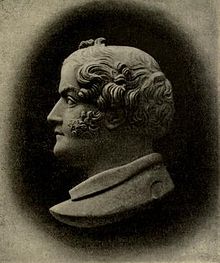
Back بينيديتو بيستروتشى ARZ Benedetto Pistrucci German Benedetto Pistrucci Spanish Benedetto Pistrucci French Benedetto Pistrucci Galician Benedetto Pistrucci Italian Benedetto Pistrucci Romanian Пиструччи, Бенедетто Russian Benedetto Pistrucci Swedish Бенедетто Піструччі Ukrainian

Benedetto Pistrucci (29 May 1783 – 16 September 1855) was an Italian gem-engraver, medallist and a coin engraver, probably best known for his Saint George and the Dragon design for the British sovereign coin. Pistrucci was commissioned by the British government to create the large Waterloo Medal, a project which took him thirty years to complete.
Born in Rome in 1783, Pistrucci studied briefly with other artists before striking out on his own at age 15. He became prominent as a cameo carver and was patronised by royalty. In 1815, he moved to Britain, where he would live for most of the rest of his life. His talent brought him to the attention of notables including William Wellesley-Pole, the Master of the Mint. Pole engaged Pistrucci to design new coinage, including the sovereign, which was first issued in 1817 to mixed reactions. Although Pole probably promised Pistrucci the post of Chief Engraver, the position could not be awarded as only a British subject could hold it. This slight became a long-term grievance for Pistrucci.
Talented but temperamental, Pistrucci refused to copy the work of other artists. When in 1823 George IV demanded that an unflattering portrait of him on the coinage be changed with a new likeness to be based on the work of Francis Chantrey, Pistrucci refused and was nearly dismissed. The Mint did not dismiss him, lest the money already spent on the Waterloo Medal be wasted. Pistrucci kept his place with the Mint for the rest of his life, eventually completing the Waterloo Medal in 1849, though because of its great size it could not be struck. After Pistrucci's death, the George and Dragon design was restored to the sovereign coin, and is still used today.